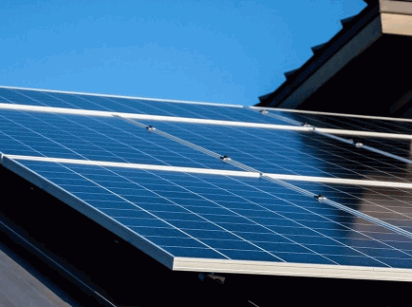Considering installing solar panels on your house but unsure about the benefits and costs associated with them?
We explore what solar panels are, how they work, and the numerous benefits they offer, such as reduced electricity bills and increased property value.
We also discuss the different types of solar panels available, factors to consider before installation, and the overall cost involved. Learn how you can harness the power of the sun for your home!

What Are Solar Panels?
Solar panels are advanced technological devices that harness sunlight to generate electricity, contributing to the utilization of renewable energy sources.
These panels work by absorbing photons from sunlight, which in turn creates an electric field across the layers of the panel, generating direct current (DC) electricity. This DC electricity is then transformed into alternating current (AC) electricity, which can be used to power homes, businesses, and even entire cities.
Solar power is a clean and sustainable source of energy that reduces greenhouse gas emissions and dependence on fossil fuels. The widespread adoption of solar energy plays a crucial role in combating climate change and creating a more sustainable future for generations to come.

How Do Solar Panels Work?
Solar panels convert sunlight into electricity through the photovoltaic effect, enabling the sustainable generation of clean energy for various applications.
The key component within solar panels responsible for this conversion is the solar cells. These cells are made from materials like silicon, which creates an electric field when exposed to sunlight. When photons from the sunlight strike the solar cells, they knock electrons loose from their atoms. These freed electrons create a flow of electricity, which is then captured and converted into usable power. This process of harnessing solar power through solar panels is essential for enhancing energy efficiency and reducing reliance on traditional fossil fuels.

What Are The Benefits Of Installing Solar Panels?
Installing solar panels on your house offers a multitude of benefits, including significant energy savings, environmental friendliness, and a sustainable source of electricity.
- By harnessing the power of renewable energy from the sun, solar panel installation not only decreases your reliance on conventional electricity sources but also helps reduce your carbon footprint.
- The energy-saving benefits of solar panels extend beyond monetary savings, as they contribute to a greener environment by producing clean energy without harmful emissions.
- Embracing solar energy as a cost-effective solution is a smart investment in the future, offering long-term sustainability and a more eco-friendly way to power your home.
Reduced Electricity Bills
One of the primary benefits of installing solar panels is the substantial reduction in electricity bills, leading to long-term energy savings and cost-effective power generation solutions.
By harnessing solar power, individuals can significantly lower their monthly utility costs and minimize their reliance on traditional energy sources, ultimately contributing to a more sustainable and eco-friendly lifestyle. The key lies in the energy efficiency of solar panels, which enable users to capitalize on the abundant sunlight to generate electricity for various household and commercial purposes. This shift towards renewable energy not only fosters financial stability but also aligns with the global efforts to combat climate change by reducing carbon emissions and promoting solar savings.
Renewable Energy Source
Solar panels serve as a renewable energy source, aligning with sustainable living practices and reducing reliance on traditional non-renewable energy sources.
By harnessing the power of the sun to generate electricity, solar energy plays a crucial role in fostering energy independence and environmental stewardship. Transitioning to solar panels not only helps in combatting climate change but also contributes to reducing greenhouse gas emissions. Embracing green technology like solar energy is a step towards a more sustainable future, promoting cleaner air, water, and overall healthier living environments.
The scalability and versatility of solar panels make them a viable option for individuals, communities, and businesses looking to decrease their carbon footprint and embrace renewable energy solutions.
Environmental Benefits
The installation of solar panels offers significant environmental benefits by promoting clean energy production, reducing carbon footprint, and mitigating the negative impacts of traditional power generation methods.
By harnessing the power of sunlight, solar panels generate electricity without producing greenhouse gas emissions or air pollutants, making them a sustainable energy solution. This renewable energy source plays a crucial role in combating climate change by reducing our dependence on fossil fuels and decreasing the overall carbon footprint of buildings and communities. In addition to the environmental advantages, solar installation also helps to lower energy costs over time, providing long-term savings while contributing to a cleaner and healthier planet for future generations.
Increased Property Value
Installing solar panels can enhance the property value of your home, making it a valuable investment in sustainable home improvement and energy-efficient upgrades.
Solar installations not only lower utility costs but can also attract eco-conscious buyers who are willing to pay a premium for homes with energy-saving features. Government solar incentives and rebates can offset upfront costs, making solar panels a financially savvy choice for homeowners. By incorporating renewable energy sources like solar power, homeowners can align their properties with the growing demand for sustainable living, further boosting their home’s desirability in the real estate market.

What Are The Different Types Of Solar Panels?
Solar panels come in various types, including monocrystalline, polycrystalline, and thin-film options, each with distinct characteristics and efficiency levels.
- Monocrystalline solar panels are known for their high-efficiency rates and longevity, making them ideal for residential installations where space is limited.
- On the other hand, polycrystalline panels are more cost-effective but slightly less efficient. They are suitable for larger solar arrays or commercial projects where cost savings are crucial.
- Thin-film panels, though less efficient than crystalline types, are flexible and lightweight, making them perfect for unconventional installations like curved roofs or portable solar setups.
Take a look: How To Clean Solar Panels
Monocrystalline Solar Panels
Monocrystalline solar panels are known for their high efficiency and durability, making them a popular choice for residential and commercial solar installations.
Their efficiency is derived from the way they are made, consisting of single-crystal silicon, which enables them to convert sunlight into electricity with minimal energy loss. This results in higher power output compared to other types of solar panels.
Their longevity is remarkable, with many monocrystalline panels having a lifespan of 25-30 years or more, making them a cost-effective investment in the long run. These qualities make monocrystalline solar panels particularly suitable for rooftop installations in homes and businesses, where space may be limited but efficiency is crucial.

Polycrystalline Solar Panels
Polycrystalline solar panels offer a cost-effective solution for solar power generation, balancing efficiency with affordable production costs for widespread adoption.
The cost-effectiveness of these solar panels stems from their efficient production process, which allows for competitive pricing in the market. By optimizing the use of materials during manufacturing, polycrystalline panels maintain a good balance between cost and performance. This affordability plays a crucial role in making solar energy solutions accessible to a broader range of consumers, helping to drive the renewable energy transition forward. The installation and maintenance costs associated with polycrystalline solar panels are relatively lower compared to other types, enhancing their attraction to both residential and commercial solar projects.

Thin-Film Solar Panels
Thin-film solar panels are valued for their flexibility and ease of installation, offering versatile options for integrating solar technology into various structures and surfaces.
Their lightweight and bendable design makes them suitable for unconventional solar panel placements, such as on curved surfaces or embedded in building materials. This adaptability opens up possibilities for solar panel installation on rooftops, facades, and even windows, maximizing energy generation in urban environments with limited space for traditional solar panels.

What Are The Factors To Consider Before Installing Solar Panels?
Before installing solar panels, it is essential to consider factors such as location, sunlight availability, roof type, angle, energy requirements, and budget constraints to optimize the solar installation process.
The location plays a crucial role in determining the efficiency of solar panel placement. Rooftops that receive ample sunlight throughout the day are ideal for maximizing energy generation. The angle at which the panels are installed also affects their performance. It is important to place the solar panels in a position where they can capture the most sunlight.
Considering your energy consumption patterns and the size of your property will help determine the number of panels needed to meet your energy demands.
Location And Sunlight Availability
The location and sunlight availability play a crucial role in determining the effectiveness of solar panel installations, ensuring optimal exposure to sunlight while minimizing shading factors.
Choosing the right location for solar panels is essential for maximizing their energy production. Solar panels work most efficiently when they receive direct sunlight for the majority of the day. When selecting a location, it is important to consider any potential obstructions that could cause shading, such as nearby trees or buildings. Proper solar panel orientation, ensuring they face towards the sun’s path during the day, is key to harnessing maximum sunlight. Solar monitoring systems can help in tracking the performance of the panels and making adjustments for optimal positioning.
Roof Type And Angle
The roof type and angle are critical considerations for solar panel installations, influencing the efficiency of energy generation and the overall performance of the solar array.
The shape and material of the roof can impact how much sunlight reaches the solar panels throughout the day. The angle of the roof can determine the optimal tilt angle for the solar panels to maximize their exposure to sunlight. By adjusting the tilt angle based on the geographical location and solar panel size, homeowners can significantly increase the energy output of their solar system. Choosing the right roof specifications and tilt angles can lead to greater solar panel efficiency and ultimately, more savings on energy bills.
Energy Needs And Budget
Understanding energy needs and setting a suitable budget are essential steps before installing solar panels, ensuring that the system meets your electricity requirements while considering cost-effective financing options.
- By accurately assessing your energy consumption patterns, you can determine the optimal capacity of solar panels needed to offset your electricity usage. Aligning your energy needs with your solar panel capacity not only ensures efficiency but also maximizes energy savings in the long run.
- When allocating a budget for solar panel installation, it is crucial to factor in upfront costs, ongoing maintenance expenses, and potential rebates or incentives available. Exploring various solar financing options such as loans, leases, or power purchase agreements can make sustainable investments more accessible and manageable for homeowners or businesses looking to embrace renewable energy sources.
What Is The Cost Of Installing Solar Panels?
The cost of installing solar panels varies based on upfront expenses, but the long-term savings in energy bills and environmental benefits make it a cost-effective investment in renewable energy.
When considering the cost of solar panel installations, it’s essential to analyze the return on investment. While the upfront expenses might seem significant, the savings on electricity bills over the years are substantial. The payback period for solar panels, typically ranging from 5 to 15 years, showcases the financial benefits in the long run. With various financing options and government incentives available, the affordability of solar technology has significantly improved, making it an attractive option for both residential and commercial properties.

Upfront Costs
The upfront costs of solar panel installation include expenses for equipment, labor, and permits, but various financing options and rebates can help offset the initial investment for a more affordable transition to solar power.
When considering solar panel financing, homeowners have the choice of taking out a solar loan, utilizing a home equity line of credit (HELOC), or entering a power purchase agreement (PPA) for a leased solar system. These options can make the upfront costs more manageable by spreading them out over time.
There are numerous incentives available such as the federal Investment Tax Credit (ITC) and local solar rebate programs, which can significantly reduce the overall cost of going solar. It’s important for individuals to explore these financial incentives to maximize savings and make the switch to solar energy a financially savvy decision.
Long-Term Savings
The long-term savings from solar panels result from reduced energy bills, enhanced energy efficiency, and minimal maintenance costs, making it a sustainable and cost-effective investment in clean energy solutions.
Installing solar panels on your property not only helps you save on electricity costs in the long run but also significantly boosts your overall energy efficiency. By generating your own electricity from the sun’s abundant source of power, you reduce your reliance on traditional utilities, ultimately lowering your monthly energy bills. The maintenance requirements for solar panels are typically minimal, ensuring that your investment continues to pay off without significant ongoing expenses. This efficient energy solution not only benefits your wallet but also contributes to a more sustainable and eco-friendly future.
How To Install Solar Panels On Your House?
The installation process of solar panels involves consultation, design, permitting, inspection, and maintenance stages to ensure a seamless transition to sustainable energy generation at your home.
During the consultation phase, a solar installer will assess your home’s energy needs and roof space to determine the optimal placement of the panels. Once the design is finalized, the permitting process begins, which involves obtaining approval from local authorities. Inspections are then conducted to ensure the system meets safety and efficiency standards. Ongoing maintenance tasks such as regularly cleaning the panels to maximize energy production and checking the system for any issues are crucial for the long-term performance of your solar installation.

Consultation And Design
The initial stages of installing solar panels involve consulting with experts, designing the system layout, and selecting a reputable solar installer to ensure the efficiency and effectiveness of the installation process.
Consultation with experts is crucial in determining the most suitable solar panel technology for your specific energy needs. The design phase plays a pivotal role in achieving optimal performance by strategically placing solar panel components to maximize sunlight exposure. Solar installers bring valuable expertise in executing the installation process, ensuring that the system is set up correctly for long-term functionality. Professional input in designing solar arrays is essential to create a system that efficiently generates and harnesses solar energy, leading to cost savings and environmental benefits.
Permitting And Inspection
Obtaining necessary permits and undergoing inspections are crucial steps in the solar panel installation process to comply with local regulations and ensure the safety and compliance of the solar array.
- Local authorities typically require individuals or companies installing solar panels to obtain permits to ensure that the installation meets building codes and safety standards.
- Inspections are conducted to verify that the system is installed correctly, minimizing the risk of electrical hazards or structural issues.
- Adhering to solar panel regulations not only ensures legal compliance but also promotes the longevity and efficiency of the solar energy system.
- It is essential to prioritize safety measures and follow the guidelines set by regulatory bodies to avoid any complications in the installation process.
Installation Process
The installation process of solar panels involves mounting the system on rooftops, connecting it to the electrical grid, and integrating energy sources to begin harnessing clean and sustainable solar power.
- In terms of rooftop mounting procedures, it is essential to ensure that the panels are strategically placed to maximize sunlight exposure throughout the day, optimizing energy generation. This positioning is crucial for the efficiency of the solar power system.
- The grid connection aspect plays a vital role in enabling users to both consume solar-generated electricity and feed excess power back into the grid, promoting a two-way flow of energy. The seamless integration of solar technology allows for a constant and reliable source of renewable energy, reducing dependence on traditional fossil fuel-based power sources.
Maintenance And Upkeep
Regular maintenance and cleaning of solar panels are essential to ensure optimal performance, maximize energy efficiency, and prolong the lifespan of the solar array for long-term benefits.
By keeping the solar panels clean and well-maintained, you are not only ensuring that your system operates at its best but also reducing the risk of potential damage. Dust, dirt, and debris can accumulate on the panels over time, hindering their ability to absorb sunlight effectively.
Establishing a routine for solar panel cleaning not only enhances energy production but also contributes to cost savings by preventing the need for extensive repairs.
Regular maintenance can help in identifying any issues early on, ensuring that your system remains efficient and reliable for years to come.

